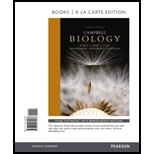
Campbell Biology, Books a la Carte Plus Mastering Biology with eText -- Access Card Package (10th Edition)
10th Edition
ISBN: 9780133922851
Author: Jane B. Reece, Lisa A. Urry, Michael L. Cain, Steven A. Wasserman, Peter V. Minorsky, Robert B. Jackson
Publisher: PEARSON
expand_more
expand_more
format_list_bulleted
Concept explainers
Question
Chapter 17, Problem 13TYU
Summary Introduction
To explain: The pattern of Siamese cat’s fur pigmentation due to ‘temperature-sensitive’ mutation in the gene encoding dark fur pigment.
Concept introduction:
Siamese cats have unique fur pigmentation pattern known as ‘colorpoints’. The pattern includes dark ears, face, legs, and tail, while a creamy white shade is seen on the back and belly. They are partial albinos. This is caused due to a ‘temperature-sensitive’ mutation in the gene encoding tyrosinase enzyme required for the melanin production. It does not work at normal body temperatures.
Expert Solution & Answer
Trending nowThis is a popular solution!

Students have asked these similar questions
What are biofertilizers and mention the significance
PCBs and River Otters: Otters in Washington State’s Green-Duwamish River have high levels of polychlorinated biphenyls (PCBs) in their livers. PCBs can bind to the estrogen receptors in animals and disrupt the endocrine system of these otters. The PCBs seem to increase the estrogen to androgen ratio, skewing the ratio toward too much estrogen.
How would increased estrogen affect the river otter population?
Based on your reading of the materials in this unit, what factors can affect fertility in humans?
Explain how each of the factors affecting human fertility that you described can disrupt the human endocrine system to affect reproduction.
Other than oil and alcohol, are there other liquids you could compare to water (that are liquid at room temperature)?
How is water unique compared to these other liquids?
What follow-up experiment would you like to do, and how would you relate it to your life?
Chapter 17 Solutions
Campbell Biology, Books a la Carte Plus Mastering Biology with eText -- Access Card Package (10th Edition)
Ch. 17.1 - Prob. 1CCCh. 17.1 - What polypeptide product would you expect from a...Ch. 17.1 - Prob. 3CCCh. 17.1 - Prob. 4CCCh. 17.2 - MAKE CONNECTIONS In a research artide about...Ch. 17.2 - What enables RNA polymerase to start transcribing...Ch. 17.2 - Prob. 3CCCh. 17.3 - Prob. 1CCCh. 17.3 - How is RNA splicing similar to how you would watch...Ch. 17.3 - Prob. 3CC
Ch. 17.4 - What two processes ensure that the correct amino...Ch. 17.4 - Prob. 2CCCh. 17.4 - Prob. 3CCCh. 17.4 - Prob. 4CCCh. 17.4 - WH AT IF? In eukaryotic cells, mRNAs have been...Ch. 17.5 - What happens when one nucleotide pair is lost from...Ch. 17.5 - MAKE CONNECTIONS Individuals heterozygous for the...Ch. 17.5 - WHAT IF? DRAW IT The template strand of a gene...Ch. 17 - Describe the process of gene expression, by which...Ch. 17 - What are the similarities and differences in the...Ch. 17 - What function do the 5' cap and the poly-A tail...Ch. 17 - Prob. 17.4CRCh. 17 - What will be the results of chemically modifying...Ch. 17 - In eukaryotic cells, transcription cannot begin...Ch. 17 - Which of the following is not true of a codon? (A)...Ch. 17 - The anticodon of a particular tRNA molecule is (A)...Ch. 17 - Which of the following is not true of RNA...Ch. 17 - Which component is not directly involved in...Ch. 17 - Using Figure 17.6, identify a 5' 3' sequence of...Ch. 17 - Prob. 7TYUCh. 17 - Would the coupling of the processes shown in...Ch. 17 - Prob. 9TYUCh. 17 - Prob. 10TYUCh. 17 - Prob. 11TYUCh. 17 - Prob. 12TYUCh. 17 - Prob. 13TYU
Knowledge Booster
Learn more about
Need a deep-dive on the concept behind this application? Look no further. Learn more about this topic, biology and related others by exploring similar questions and additional content below.Similar questions
- Selection of Traits What adaptations do scavengers have for locating and feeding on prey? What adaptations do predators have for capturing and consuming prey?arrow_forwardCompetition Between Species What natural processes limit populations from growing too large? What are some resources organisms can compete over in their natural habitat?arrow_forwardSpecies Interactions Explain how predators, prey and scavengers interact. Explain whether predators and scavengers are necessary or beneficial for an ecosystem.arrow_forward
- magine that you are conducting research on fruit type and seed dispersal. You submitted a paper to a peer-reviewed journal that addresses the factors that impact fruit type and seed dispersal mechanisms in plants of Central America. The editor of the journal communicates that your paper may be published if you make ‘minor revisions’ to the document. Describe two characteristics that you would expect in seeds that are dispersed by the wind. Contrast this with what you would expect for seeds that are gathered, buried or eaten by animals, and explain why they are different. (Editor’s note: Providing this information in your discussion will help readers to consider the significance of the research).arrow_forwardWhat is the difference between Uniporters, Symporters and Antiporters? Which of these are examples of active transport?arrow_forwardWhat are coupled transporters?arrow_forward
- How do histamine and prostaglandins help in the mobilization of leukocytes to an injury site? What are chemotactic factors? How do they affect inflammation process?arrow_forwardCompare and contrast neutrophils and macrophages. Describe two ways they are different and two ways they are similar.arrow_forwardDescribe the effects of three cytokines (not involved in the initial inflammation response). What cells release them?arrow_forward
arrow_back_ios
SEE MORE QUESTIONS
arrow_forward_ios
Recommended textbooks for you
 Biology Today and Tomorrow without Physiology (Mi...BiologyISBN:9781305117396Author:Cecie Starr, Christine Evers, Lisa StarrPublisher:Cengage Learning
Biology Today and Tomorrow without Physiology (Mi...BiologyISBN:9781305117396Author:Cecie Starr, Christine Evers, Lisa StarrPublisher:Cengage Learning

Biology Today and Tomorrow without Physiology (Mi...
Biology
ISBN:9781305117396
Author:Cecie Starr, Christine Evers, Lisa Starr
Publisher:Cengage Learning